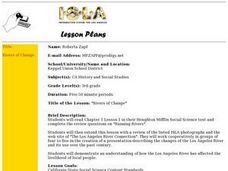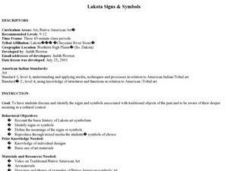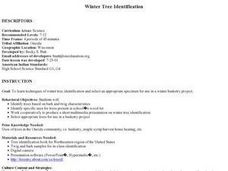Curated OER
Centennial: Have I Got a Story for You
Students identify the clues that folklore provides about Utah's past, and create a piece of folklore for a place or event in or near their community.
Curated OER
Get to Know Your City
Third graders research the history of their home city and how it's development was influenced by different groups of people. They present their research information to the class.
Curated OER
Rivers of Change
Third graders examine rivers and how they affect the people living around them. They read a chapter in their science text, take a virtual river tour online, read a background information story, and in pairs describe the changes in the...
Curated OER
Ecoregions of Texas
Seventh graders discuss why hunter-gatherers might have favored certain areas in which to live. In pairs, they research specific regions to examine in depth. Students present their eco-region vegetation findings (in this case Central...
Curated OER
Lakota Signs & Symbols
Students discuss and identify the signs, symbol, and sacred animals associated with traditional Lakota objects of the past. They then design and create a two-dimensional piece of art that incorporates one of these signs or symbols.
Curated OER
Corn Husk Doll
Students practice melody and lyrics and the feelings they represent, in two languages, sing the melody of the Corn Husk Doll, lyrics Maria Hinton, melody by Patti Morin in Oneida, and discuss how the words to this song demonstrate...
Curated OER
Winter Tree Identification
Students utilize techniques of winter tree identification such as twig and bark characteristics. Students also identify specific uses for trees in school surrounding. They work cooperatively to produce a multimedia presentation on...
Curated OER
Fur Trade Economics
Learners demonstrate understanding of what the fur trade was and how it was operated, including the bartering process, by participating in a mock trade activity and assessing the value of items based on their needs and wants.
Curated OER
Who are the Women of the Pacific North West: 1830-1870?
Students view a picture from the Vancouver National Historic Reserve and discuss the people in the picture. They locate Cromwell's Map and discuss the villages located close to Fort Vancouver. Students read information regarding the role...
Curated OER
Wright Brothers Centennial: North Carolina, Geography and History
Fourth graders identify symbols, people and events associated with North Carolina history. Using this information, they focus on the Wright brothers and their first flight. They answer questions related to the event and discuss how...
Curated OER
The Art of the Puerto Rican People
Students study Taino Art and identify their crafts and stone carvings. They read the life of Campeche as presented and discuss with their teacher the economic and political situation of Puerto Rico in the eighteenth century and how...
Curated OER
Labor Needs in Colonial America
Students examine the labor needs in colonial America. Using primary and secondary resources, they explore the major events and life in the United States during colonial times. They complete a chart listing the pros and cons of a slave...
Curated OER
Creating a digital Self-Portrait
Sixth graders use a digital camera and take photographs of each other wearing a "costume" of their choice in front of a blue screen. They work cooperatively to complete the photographs by placing it into a background and setting...
Curated OER
Native People of the Caribbean
Eleventh graders use a map and locate and define the Caribbean region and then work in groups to read the passage and timeline. The groups' reader will read the passage aloud and the recorder makes a list of why colonists used slave...
Curated OER
Caribbean Music-- An Introduction
For this music worksheet, students investigate the history of music and the musical style of the Caribbean islands. Students read a 1 page information sheet about the region and its music. Students answer 8 questions.
Curated OER
Thoreau, Gandhi, and Martin Luther King, Jr.
Students explore the concept of non-violent resistance. In this political philosophies lesson, students study the political tactics of Mohandas Gandhi, Henry David Thoreau, and Martin Luther King, Jr. in order to discover how each of...
Curated OER
The History of Maple Syrup
Students explore the process of harvesting maple syrup. In this science and history lesson, students make their own maple syrup and create a picture book that shows the Native American and American pioneer methods of making the syrup.
Curated OER
Looking at Ritual and Ceremony
Students explore Edward Curtis' photos of a Native American ritual and practice documenting their own religious rituals. For this photography analysis lesson, students analyze an Native American ritual in Curtis' photo. Students discuss...
Curated OER
The Ghost Catcher
Second graders read the story The Ghost Cather and complete activities related to the book. For this language arts lesson plan, 2nd graders complete comprehension questions, art projects, and more.
Curated OER
African American Traditions: Cameroonian and African-American Folktales
Young scholars compare Cameroonian and African-American folktales. In this folktales lesson plan, students participate in a jigsaw activity that requires them to read "The Owl Never Sleeps as Night," "Why the Lizard Often Nods," "Tappin,...
Curated OER
Arab Americans: In the Aftermath of the Terrorist Attacks on the U.S.
Students examine the effects of the terrorist attacks in 2001. In this lesson on discrimination and the dangers of stereotyping, students will expand their understanding of stereotyping in contemporary society and compare in to similar...
Curated OER
Gold Rush Abolitionists: How different was the role of Spanish-speaking blacks under Mexican rule from the role of English-speaking blacks under U.S. rule?
Students determine how Spanish-speaking blacks and English speaking blacks were treated differently. For this emancipation lesson, students compare the Mexican and American rules regarding slavery.
Curated OER
Treaties
Second graders explore Canadian history by investigating the First Nations. In this Aboriginal treaty lesson, 2nd graders identify the specific agreements made between European settlers and Aboriginals which caused the formation of...
Curated OER
Thirteen Moons Language Lesson
First graders pronounce and define the Thirteen Moon Cycles in Oneida language. In this multicultural literacy and calendar lesson, 1st graders view a video clip in which Oneida elder speakers say the name of each moon and explain its...

























